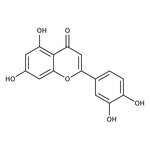Search Thermo Fisher Scientific
Thermo Scientific Chemicals
3',4',5,7-Tetrahydroxyflavone, 97%
CAS: 491-70-3 | C15H10O6 | 286.239 g/mol
Catalog number ALFL14186.ME
Price (MYR)
1,764.00
EA
Quantity:
500 mg
Price (MYR)
1,764.00
EA
Specifications
Chemical Name or Material3',4',5,7-Tetrahydroxyflavone
CAS491-70-3
Health Hazard 1H315-H319-H335
Health Hazard 2GHS H Statement
H315-H319-H335
Causes skin irritation.
Causes serious eye irritation.
May cause respiratory irritation.
H315-H319-H335
Causes skin irritation.
Causes serious eye irritation.
May cause respiratory irritation.
Health Hazard 3P261-P264b-P271-P280-P302+P352-P304+P340-P305+P351+P338-P312-P332+P313-P362-P501c
View more
3',4',5,7-Tetrahydroxyflavone is used as an apoptosis inducer.
This Thermo Scientific Chemicals brand product was originally part of the Alfa Aesar product portfolio. Some documentation and label information may refer to the legacy brand. The original Alfa Aesar product / item code or SKU reference has not changed as a part of the brand transition to Thermo Scientific Chemicals.
Applications
3′,4′,5,7-Tetrahydroxyflavone is used as an apoptosis inducer.
Solubility
Soluble in aqueous alkaline solutions (1.4 mg/ml), ethanol (∼5 mg/ml), dimethyl sulfoxide (7 mg/ml), 1eq. Sodium hydroxide (5 mM), dimethylformamide (∼20 mg/ml), water (1 mg/ml) at 25°C and methanol.
Notes
Incompatible with strong oxidizing agents. Store in cool place. Keep container tightly closed in a dry and well-ventilated place. Recommended storage temperature is 2 - 8°C.
3′,4′,5,7-Tetrahydroxyflavone is used as an apoptosis inducer.
Solubility
Soluble in aqueous alkaline solutions (1.4 mg/ml), ethanol (∼5 mg/ml), dimethyl sulfoxide (7 mg/ml), 1eq. Sodium hydroxide (5 mM), dimethylformamide (∼20 mg/ml), water (1 mg/ml) at 25°C and methanol.
Notes
Incompatible with strong oxidizing agents. Store in cool place. Keep container tightly closed in a dry and well-ventilated place. Recommended storage temperature is 2 - 8°C.
RUO – Research Use Only
General References:
- NK Peters.; JW Frost.; SR Long. A plant flavone, luteolin, induces expression of Rhizobium meliloti nodulation genes. Science. 1986, 233 (4767), 977-980.
- Seelinger G.; Merfort I.; Schempp CM. Anti-oxidant, anti-inflammatory and anti-allergic activities of luteolin. Planta Medica. 2007, 208 (15), 1694-1706.
- Anti-oxidant and radical scavenger in biological systems: Methods Enzymol., 234, 420 (1994).



